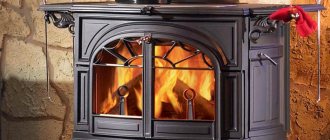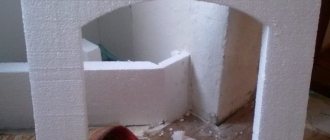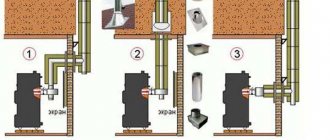Although the potbelly stove has a history of more than a century, it has not ceased to be a very popular heating device for small rooms.
Potbelly stove from a gas cylinder
Such a stove is made not only from solid sheets of metal, but also from various metal objects that can withstand the heat from an intense flame - it could be a barrel, a flask, a pipe or an old gas cylinder.
It is especially popular among avid motorists who, even in winter, cannot refuse improvements to their car, spending all their free time in garages. The gas cylinder has an ideal shape, it’s practically a potbelly stove, you just need to improve it slightly: cut off the excess, drill the necessary holes and add a few pipes! Let's take a closer look at how to make a potbelly stove from a cylinder?
A potbelly stove made from a gas cylinder can have a vertical or horizontal arrangement. Some craftsmen even make such stoves from two cylinders, placing one of them in a vertical position on top of the other, which is oriented horizontally.
Video: homemade wood-burning stove made from two cylinders
However, there are many models, and after considering different ones, you can choose the one that seems more convenient to use and acceptable in ease of execution.
Naturally, to make a potbelly stove from a cylinder you will need some tools and materials, as well as certain skills in working with them.
Pros and cons of a gas cylinder garage stove
The main task of the stove is to warm up the garage. She copes with this in a short time and with low fuel consumption. As a rule, food is not cooked on a stove from gas cylinders; at most, they heat up dishes taken from home or boil a kettle. If such functions are not needed, then you can limit yourself to the simplest option of one cylinder without a hob.
Types of garage stoves:
- Simple design. A small stove for a garage is built with your own hands from one cylinder with a capacity of 12-27 liters. It is installed horizontally or vertically.
- A stove made of two containers. There are different connection options available here. Two cylinders are placed with the long side above each other and connected by welding. The design of cylinders welded at right angles is a little more complicated.
- Complex options from two or more containers. There may be cooking surfaces, heat exchange fins or baffles, an air damper and other improvements.
During operation, the stove body becomes red hot, the screens protect against burns and at the same time increase the efficiency of the heater by directing cold air from the floor to the cylinder.
Pros and cons of some design options:
- On a vertically installed stove, you can make a platform on top for heating food, but the wood will have to be chopped into small fragments so that it fits in the firebox.
- The horizontal option is simpler in this regard: firewood is loaded along the long side, so you can use any logs. However, it is quite difficult to arrange a burner on a horizontally located cylinder.
It is not too difficult to make a stove for a garage from 2 gas cylinders installed parallel to each other, but you will have to forget about the hob. Its advantages are that you can use long logs, which provides quick and relatively long heating of the garage. On a design with a perpendicular connection of containers, it is easier to make a burner for heating food, but the stove itself is more difficult to make.
Important! Gas cylinder stoves are only suitable for temporary heating of a garage. With constant work, there is a real threat of fire: the metal of the walls will burn out very quickly, and the fire will spread to flammable objects and substances, of which there is always a lot in the garage.
The design of the stove and its principle of operation
Like any solid fuel stove, a potbelly stove made from a gas cylinder has two main structural compartments: a firebox and an ash pit (ash pan).
The working process takes place in the firebox - fuel combustion. The ash pan is located under the firebox, directly connected to it through a grate and serves to remove non-volatile combustion products from the firebox.
Horizontal and vertical execution
During the combustion process, combustion products are formed. Volatiles are eliminated through the chimney under the influence of natural draft, and loose ones are eliminated through the holes in the grate into the ash pan. Subsequent removal of bulk combustion products from the ash pan is done manually using a poker or spatula.
The ash pan also serves to supply air to the combustion chamber (furnace). Therefore, it should be cleaned promptly. Without a normal air supply, fuel combustion efficiency is significantly reduced.
The heat from the stove comes into the room directly from the hot walls of the firebox.
What you need to make a stove from a gas cylinder for a garage
Home craftsmen really do not like to use purchased parts. They prefer to use everything that has accumulated in the garage over the years. Used gas cylinders are not always on hand, but they can be purchased relatively inexpensively. What to pay attention to:
- A stove for heating a garage is made only from all-metal gas cylinders. Composite containers made of polymers cannot be used.
- Gas cylinders with a volume of 5, 12, 27 liters are not worth choosing for a garage stove. They will not warm the room or provide too little heat.
- The optimal choice is a 50-liter cylinder with a length of 850 mm and a diameter of 300 mm. Its walls are thick enough to withstand any heat.
- You can make a stove from an industrial 40-liter cylinder. It is slightly narrower and longer, and the metal of the body is thicker. The container is too narrow and heavy, but it will do in a pinch.
- It is more convenient to work with a gas cylinder equipped with a valve rather than a valve. The valve can be used as a power regulator when supplying air to the stove.
What you will need:
- welding machine;
- grinder (angle grinder);
- metal sheets 2-3 mm thick;
- profile for legs;
- rod or fittings for grates.
In addition to the above, you will need a hammer, screwdrivers, fasteners, drill, vice, etc. As a rule, all this is available in any garage. If the containers you choose are too large and heavy, some friendly help will be helpful.
Important! You can work with a grinder or other tool that creates sparks only after filling the gas cylinder to the top with water: propane is heavier than air, it will not evaporate from the container on its own.
Which cylinder is suitable
When choosing a cylinder for making a homemade stove, you should follow these recommendations:
- The cylinder must be made of solid metal (without holes, cracks, etc.).
- It is better not to use composite cylinders, as they are not heat-resistant enough and can easily ignite.
- Small household cylinders (with a capacity of up to ten liters) are not suitable as they will be impractical.
- It is best for a small room to use medium cylinders with a capacity of twelve to seventeen liters.
- For a large stove, large propane structures with a capacity of fifty liters and a height of about three meters should be used.
- You should also use cylinders that have a valve rather than a valve, since otherwise it will regulate the air flow and its supply less.
Also, these stoves can be constructed from medium cylinders up to ten liters, but in this case they can be small portable versions of potbelly stoves.
Horizontal system
This stove has the following features:
- It is much faster to make than a vertical system.
- It must be installed on a steel sheet in order to comply with fire safety regulations.
- This design provides for a horizontal position of the cylinder, and its installation in a “lying” position.
Vertical system
The vertical stove has the following features of its system:
- Takes up much less space than a horizontal design.
- It can be placed either in the center of the room or in any of the corners.
- The door and grates will be in a completely different position weeks in a horizontal oven.
Drawings of a stove for a garage from a gas cylinder
The dimensions indicated in the figures are quite relative and are tied to the dimensions of the cylinder chosen for the stove. The diagrams give an idea of the principle of operation, design features and method of connecting containers. Some of the parts (burner, shaped handles) can be ignored, but the main structural elements (ash pan, grate, chimney) are necessary for the efficient and safe operation of the stove.
From a large diameter cylinder you can make a stove for a garage with a burner in the upper part. The ash pan is the lower part of the firebox where ash accumulates, and the ash pit is the hole in the side wall of the stove to control draft. The internal partition in the garage stove increases heat transfer due to convection
Important! The thickness of the stove walls should be within 3-5 mm. Moreover, the upper value is recommended, since 3 mm steel will burn out quite quickly.
How to make a stove for a garage from a cylinder
Preparing the container for use:
- make sure the container is empty;
- unscrew the valve;
- drain all liquid.
Remove the valve using an adjustable wrench (put a piece of pipe on the handle to increase the leverage) or a vice. In the latter case, the tap is clamped in a vice, and the cylinder is rotated using a chain and a long pipe or crowbar.
To turn the cylinder, the valve of which is clamped in tension, use a long lever
Before cutting the cylinder, water is poured inside. This can be done using a thin tube, a watering can, or any available cone-shaped container. In order for air to escape unhindered during continuous pouring (using a hose), it is necessary to move the watering can from time to time, otherwise water will flow through the top. Another option is to install a short tube of small diameter between the watering can and the neck, through which air can easily flow inside. If you pour water in portions (with a ladle, ladle), then such precautions will not be required.
When filling the cylinder, residual gas comes out of it, so this operation must be carried out in the open air or with the garage door wide open. The upper part of the cylinder is carefully cut off with a grinder; in the future, it will make an excellent door for the stove. To attach the stove door to the body, you can take ordinary metal loops (at least two) or several links of a thick chain. A rectangular groove is cut along the long side to install an ash pan (approximately 10-14 cm in width)
The grate is a grate at the bottom of the firebox on which firewood is stored. If you plan to burn with logs or scraps of boards, then the grate spacing can be several centimeters, but if sawdust is used as fuel, then a smaller distance is needed. Sometimes the grate is welded to the gas cylinder from the inside, but this is not necessary. Moreover, once the grate burns out, it will be difficult to replace.
The grate is made from scraps of rod or the reinforcement is bent into a snake
One of the necessary elements of a garage stove made from gas cylinders is a chimney. The functionality of the structure depends on the diameter of the selected pipe and its location. It is not necessary to buy a specialized pipe; you can take what you have on hand.
A small metal cylinder is welded to the hole for the smoke exit, the diameter is slightly smaller than the chimney; the pipe should fit tightly onto the outlet pipe, preventing smoke from entering the garage
Correspondence of the chimney diameter to the volume of the gas cylinder:
- 60 mm minimum for 12 l container;
- 80 mm – for a 27-liter cylinder;
- 120 mm - for a 50-liter.
The entire structure is installed on legs made of a corner or square profile
. To ensure that as much heat as possible remains in the garage, the chimney can be made from several sections of pipe connected at a slight angle. Then you need to build protective screens from sheets of metal, attach them to the body and test the stove. To create good draft, the top edge of the chimney must be placed at least 1 m above the garage roof.
How to make a stove from two gas cylinders for a garage
Getting started is no different from making a stove from a single gas cylinder. The easiest way is to place two containers with their long sides parallel to each other, one under the other. With this connection in the upper cylinder, the ash pan is not welded into the groove on the long side, but is connected to the lower one using metal strips left when cutting the hole. Firewood is placed in the lower part of the stove, and the upper container acts as a heat exchanger, retaining more heat.
The option of two containers will warm up the garage faster and retain heat longer
Heat exchange fins increase the efficiency of a garage stove made from 2 gas cylinders.
There are designs with perpendicularly welded cylinders, a cooking surface is installed in the lower one, and the upper one serves as a heat exchanger. To enhance heat transfer and better heat the garage, ribs made of metal plates are sometimes welded onto the top of the stove.
Advice! To prevent the grate from burning out when used too intensively, it can be made of a thick metal sheet with cut holes or long grooves.
Safety precautions
Precautions when operating a structure made from gas cylinders:
- The stove should be installed away from the passage to avoid accidental burns. It is also advisable to provide good lighting at the installation site. There should be no flammable objects near it on the floor and walls of the garage.
- The walls of a homemade garage oven made from a gas cylinder heat up very quickly to a high temperature. Sometimes the metal glows red. Careless touching will result in severe burns. To increase safety, the structure is fenced with one or two screens.
- The first start-up of the stove is accompanied by an unpleasant odor from paint burning on the surface of the gas cylinder. During this time, ensure good ventilation in the garage.
Important! The screens around the stove not only provide protection from burns, but also work as deflectors: they direct the flow of cold air from the floor along the hot walls, ensuring quick heating of the garage.
Safety precautions when working with equipment differ little from the recommendations when using a welding machine, grinder and other tools. We need protection for the eyes and skin of the hands, and care when handling fire and hot metal. The only thing you need to pay attention to is the preparation of the gas cylinder. Here, in addition to caution, you need to follow simple requirements - working in the open air, away from fire, i.e., taking smoke breaks over a cylinder that has not yet been filled with water is an unwise decision.
Protection of the wall and people in the building
It is clear that some kind of fencing needs to be done, but there are certain nuances here. In my case, a metal profile was used. That part of it, which is located near the wall, was made to the floor, to protect the concrete from high temperatures (I felt them when I first checked the stove) and to additionally reflect heat from the cylinders into the room. As for the outer protective wall, it must be installed at a distance of 20-30 cm from the floor. This will ensure good air circulation. The resulting convection will allow the room to be heated much faster and more evenly.
As for my particular case, after the first ignition of the stove, 20 minutes later, the temperature in the garage became such that it was possible to walk around in a shirt (with the gate closed, of course). This is despite the fact that outside at that time it did not rise above -30ºС.
Protective screens are installed, the potbelly stove is operating normally











